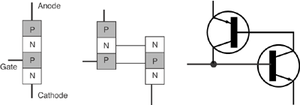Silicon controlled rectifier
|
|
A Silicon Controlled Rectifier is a 4 layer solid state device that controls current flow.
In the normal 'off' state the device restricts current flow to the leakage current. When the Gate to source current exceeds a certain point, the device turns 'on' and conducts current. The device will remain in the 'on' state even after gate current is removed so long as current through the device remains above the holding current. Once current falls below the holding current the device will switch off. If the applied voltage increases rapidly, it may induce enough leakage current to trigger the device into the on state, but this is harmful to the device.
An SCR can be seen as a conventional rectifier controlled by a gate signal. It is a 4-layered 3-terminal device. A p-type layer acts as anode and an n-type layer as a cathode; the p-type layer closer to the n-type acts as a gate.
SCRs are used in power switching, phase control, chopper, battery chargers, and inverter circuits. Industrially they are applied to produce variable DC voltages for motors (typically 5-100 HP) from AC line voltage. They can also be used in some electric vehicles to modulate the working voltage in a Jacobson circuit. Another common application is phase control circuits used with inductive loads. SCRs can also be found in welding power supplies where they are used to maintain a constant output current or voltage.

